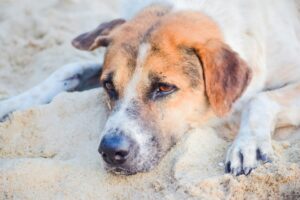As a dog parent, getting your dog to take an intolerance test helps you understand what diet they may be sensitive to. While a vet typically performs allergy tests to pinpoint allergens, intolerance tests focus on identifying substances your dog’s body system might struggle to digest.
In this post, we’ll show you what an intolerance test is, when it’s useful, and what intolerance testing kits you can try.
What Is an Intolerance Test?
A Dog Intolerance Test uses a sample of your dog’s fur and bio-resonance technology to pinpoint imbalances in their body that may be triggering some symptoms.
The test scans for reactions to a wide range of food and non-food items, and you can also include samples like dust, pollen, specific foods, treats, or shampoos you suspect may be causing issues.
When an Intolerance Test Is Useful for Your Dog
An intolerance test can be helpful if your dog is showing signs of mild, unexplained symptoms like digestive issues (e.g., bloating, gas, or diarrhea), skin irritation, or lethargy that aren’t linked to an allergy or medical condition.
It’s also helpful if you’ve noticed patterns after feeding them certain foods or using specific products but aren’t sure of the exact trigger.
The test shows sensitivities that might be hard to notice otherwise. This helps you make better choices about your dog’s diet and environment.
When an Intolerance Test May Not Be Useful
An intolerance test won’t be as helpful if your dog shows severe allergic symptoms, such as intense itching, swelling, or respiratory issues. If this is the case, it’s best for a vet to do an allergy test.
It may also not be useful if an unrelated health issue, like an infection or organ dysfunction, causes your dog’s symptoms. In this case, other types of medical testing are more appropriate.

Dog Intolerance Test vs. Allergy Test: What’s the Difference?
Here are the main differences between an intolerance test and an allergy test:
Purpose
An allergy test spots specific allergens that trigger immune responses in your dog. These allergens often cause immediate symptoms like itching or swelling. An intolerance test, on the other hand, identifies sensitivities to certain foods or substances that can cause slower, non-immune reactions, like digestive issues or skin irritation.
Method
Allergy tests usually involve blood tests, skin pricks, or intradermal tests done by a vet. An intolerance test, however, analyzes a sample of your dog’s fur using bio-resonance technology to detect imbalances in response to different substances.
Symptoms
Allergies tend to cause more intense immune reactions, while intolerances often lead to milder symptoms such as gas, stomach upset, or mild skin issues.
Usefulness
Allergy tests are essential if your dog shows severe allergic symptoms. Intolerance tests can help identify sensitivities that may be affecting your dog’s digestion or general wellness, making it easier to adjust their diet.
Ease of Testing
Only a vet can carry out an allergy test, while you can do an intolerance test at home with a simple kit. This makes an intolerance test more accessible.
Dog Intolerance Testing—A Review of UCARI and 5Strands
We reviewed two dog intolerance tests—UCARI and 5Strands—to give you an idea of what to expect from each brand. To get a better sense of the testing process and results, we got our two dogs, Chester and Olive, tested with each test kit.
Each test involved collecting a small sample of our dogs’ hair, which we were initially worried might be uncomfortable. Thankfully, Chester and Olive didn’t mind when we gently pulled a small amount of fur for UCARI and 5Strands.
Here’s a breakdown of our experience with each brand and how they compared in helping us understand our dog’s intolerances.
UCARI Pet Intolerance Test
We got the UCARI at-home intolerance test for $79.99. After ordering, we registered the kit online and cut a small piece of Chester’s and Olive’s fur to place in the provided sample bag. Once mailed, we received an immediate welcome email, followed by our results in just a few days.
The report was incredibly detailed, breaking down results into Severe, Mild, and Normal sensitivities. However, at 57 pages, the report felt overwhelming. While we liked the level of detail, a summary or action plan would have made it easier to understand and act on.
UCARI’s report left us wanting clearer guidance on what it meant to “avoid for 30 days” and how to introduce items back into their environment. On the plus side, UCARI didn’t follow up with marketing emails, which kept our inbox tidy.
5Strands Pet Food and Environmental Intolerance Test
At $148, the 5Strands intolerance test is more comprehensive, covering 380 food and environmental items. This test requires pulling about 10–15 strands of hair from the root, which we did carefully with Olive and Chester. It was surprisingly easy, and they didn’t mind the gentle tug. After mailing, the test results took about 12 days to arrive.
5Strands’ report was a more concise 11-page document, with each item alphabetized, which made it much simpler to reference and review. It also included a suggested 6-8 week elimination plan and reintroduction guide, giving us a clear way to use the results.
The result was less overwhelming and practical, which is great if you’re trying an elimination diet for the first time. Although the emails from 5Strands weren’t as polished as UCARI’s, the overall experience felt more actionable.
Which Test Is Best for Your Dog?
Both UCARI and 5Strands offer valuable insights, but they’re suited to different situations. UCARI provides in-depth detail that’s great if you’re comfortable sifting through a lot of information, while 5Strands keeps things short, clear, and easy to act on.
If you want to make immediate changes to your dog’s lifestyle, 5Strands may be the better choice. However, UCARI might appeal if you’re looking for a thorough analysis of potential sensitivities across a broader range of items.
Get the Best Pet Care with Truffle Paws
Give your pet the protection they deserve with Truffle Paws Pet Insurance. Digestive issues, food allergies, and other gastrointestinal concerns can be unpredictable and costly, but with coverage tailored to meet your pet’s needs, you can focus on their health, not the bills.
Our flexible plans cover everything from accidents and illness to cancer and prescriptions, plus optional add-ons for wellness and dental care.
Visit any licensed vet in the U.S., submit your claim online 24/7, and get reimbursed quickly.
Choose Truffle Paws for peace of mind and give your pet the care they deserve.







